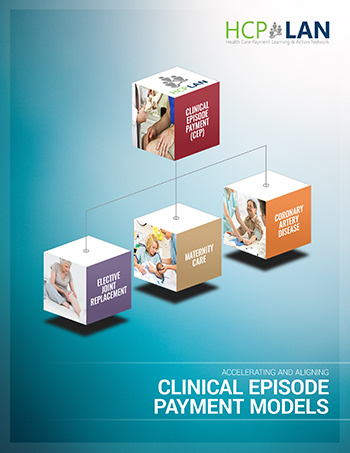
Accelerating and Aligning
Clinical Episode Payment Models
Report: Released August 1, 2016
Description
This white paper provides high-level recommendations for designing clinical episode payment models. A clinical episode payment is a bundled payment for a set of services that occur over time and across settings. The paper outlines design elements and operational considerations for three selected clinical areas: elective joint replacement, maternity care, and coronary artery disease. Recommendations are organized according to design elements and operational considerations. Design elements address questions stakeholders must consider when designing an episode payment model, including the definition, the duration of the episode, what services are to be included, and others. Operational considerations relate to implementing an episode payment model, including the roles and perspectives of stakeholders, data infrastructure issues, and the regulatory environment in which APMs must operate. The recommendations are designed to speak to a multi-stakeholder audience with the goal of supporting broad clinical episode payment adoption.
Authors
Publication Info
Publication date: August 1, 2016
146 pages
Suggested Citation: Health Care Payment Learning & Action Network. Accelerating and Aligning Clinical Episode Payment Models.
August 1, 2016.
Table of Contents
About the CMS Alliance to Modernize Healthcare
Health Care Payment Learning & Action Network (LAN)
Recommendations Framework: Design and Operations
Chapter 2: Summary of Episode Recommendations
Chapter 3: Elective Joint Replacement
Chapter 5: Coronary Artery Disease
Chapter 6: Operational Considerations
Appendix C: Elective Joint Replacement Bundled Payment Models
Appendix D: Maternity Care Bundled Payment Models
Appendix E: Coronary Artery Disease Bundled Payment Models
Appendix F: Elective Joint Replacement Implementation Resources
Appendix G: Maternity Care Implementation Resources
Appendix H: Coronary Artery Disease Implementation Resources
Appendix I: LAN Related Content
Appendix J: Principles for Patient- and Family-Centered Payment
Alternative Payment Models (APMs)
Alternative payment models deviate from traditional fee-for-service (FFS) payment, insofar as they adjust FFS payments to account for performance on cost and quality metrics, or insofar as they use population-based payments that are linked to quality performance.
Clinical Episode Payment
A clinical episode payment is a bundled payment for a set of services that occur over time and across settings. This payment model can be focused on a: setting (such as a hospital or a hospital stay); procedure (such as elective surgery); or condition (such as diabetes).
Clinical Episode Payment Work Group
The LAN Guiding Committee convened the Clinical Episode Payment (CEP) Work Group to create a set of recommendations that can facilitate the adoption of clinical episode-based payment models.
Clinical Episode Payment Models
Clinical episode payment models are different from traditional fee-for-service (FFS) health care payment models, in which providers are paid separately for each service they deliver. Instead, clinical episode payment models take into consideration the quality, costs, and outcomes for a patient-centered course of care over a set period of time and across multiple settings.
Core Set of Logic
This will assist the industry in developing the capacity for grouping claims into bundles by standardizing some of the logic and allowing each payer to customize some of the more specific rules.
Design Elements
The design elements address questions stakeholders must consider when designing an episode-based payment model, including, but not limited to, the definition, the duration of the episode, and what services are to be included.
Fee-for-Service (FFS)
Clinical episode payment models are different from traditional fee-for-service (FFS) health care payment models, in which providers are paid separately for each service they deliver.
Operational Considerations
Operational considerations relate to implementing an episode payment model, including the roles and perspectives of stakeholders, data infrastructure issues, and the regulatory environment in which APMs must operate.
Research suggests that when payments for health care are based on the care delivered in a clinical episode, the result is increased coordination of care, enhanced quality of care, and less fragmentation in the medical system. This leads to better experience and health for patients and lower costs for payers and providers. The following chapters provide high-level recommendations for designing clinical episode payment models for elective joint replacement, maternity care, and coronary artery disease. An operational considerations chapter discusses the roles and perspectives of stakeholders, data infrastructure issues, and the regulatory environment in which APMs must operate.
As the Clinical Episode Payment (CEP) Work Group was developing its recommendations for episode payments, why did they choose to recommend broad patient populations?
The Health Care Payment Learning and Action Network (LAN) sought to attribute the greatest number of patients into each episode model, because doing so increases the overall quality of care and cost savings impact of a bundled payment. It discourages the selection of only low-risk patients for coverage (“cherry-picking”) and the exclusion of higher-risk patients whose care could be more costly. However, reasonable exclusions are allowed for circumstances that might skew costs or lead to overlapping or duplicative payment (e.g., in the elective joint replacement chapter, the LAN recommends excluding patients living in nursing homes from the model population).
Why do the LAN’s clinical episode payment recommendations not discuss specific services to include or exclude from the episode model?
It was the intent of CEP Work Group to provide a discussion of the pros and cons of creating included services or excluded services. Organizations implementing episode payment will determine the specific services that can be provided within the episode definition and episode price. The Accelerating and Aligning Clinical Episode Payment Models (CEP) White Paper provides links to numerous resources to assist in developing episode model services.
Why did the LAN not recommend specific types of practitioners to serve as the accountable entity in CEP models?
Rather than prescribing which practitioner or practitioners should have the responsibility of being the accountable entity, the LAN provides recommendations on the types of experience and capabilities an accountable entity must have in order to successfully manage the episode. It is up to the entity implementing this bundle to determine which providers and clinicians would be appropriate based on their ability to engineer change, accept risk, and coordinate care. This choice may vary by market.
How transparent should this bundled payment arrangement be to the patient?
The LAN recommends that all patients included in a bundled payment arrangement should be educated about the bundled payment, including services and providers available to them during this episode of care. This is particularly critical to the shared care planning process, to ensure that patients are aware of potential additional costs that could be incurred if they receiving services from practitioners who are not participating in the episode arrangement.
How is the challenge of establishing an accountable entity addressed, given that episode-based care relies on shared accountability across all practitioners and other professionals who contribute to a patient’s care within an episode?
Across all three episode models, the LAN notes that shared accountability is a cornerstone of episode payment. Thus the recommendation relates to choosing an accountable entity or entities, with a focus on determining which entity(ies) are ready to accept risk, potentially across providers.
Why does the LAN not make a specific payment flow recommendation?
The LAN acknowledges that there are incentives and challenges to both fee-for-service (FFS) payment with retrospective reconciliation and prospective payment. The decision of which option to implement depends on the circumstances of the specific market and region in which this payment model is being implemented. It is important that regulatory barriers or legal concerns related to payment be researched, understood, and taken into consideration before this decision is made. Each episode initiative has unique circumstances which will need to be considered before a payment flow is determined. However, during the data infrastructure discussion, many implementers of clinical episode-based payment arrangements may find they do not have a data system capable of grouping claims in episodes, and will need to either purchase or build a data system with this capability. It is important for both payers and providers to work together to determine whether it would be more efficient to create or purchase this data infrastructure, or even to rely on payers to provide the necessary tools to manage the data. Chapter 6: Operational Considerations notes the benefits of prospective payment models, as well as the logistical hurdles that need to be overcome to implement this payment flow. Starting with a retrospective payment flow may be more expedient as organizations work toward addressing the obstacles to prospectively paid bundles.
How do the LAN recommendations address the importance of patient engagement?
Patients and their caregivers want and need to be fully engaged in their care; to do so, they need the proper supports and tools that will help with management of their condition. The LAN recommendations describe numerous patient engagement tools and resources, from shared care planning to helping patients to access their own health data. All patients should be provided with these tools and patient engagement opportunities, and the cost of developing and providing these tools should be considered in establishing the episode price.
Why does the type and level of risk recommendation not provide more detailed guidance on how to establish risk corridors?
The recommendations are meant to provide high-level guidance on strategies that may be used to limit risk; it will be up to payers and providers to negotiate and determine which method would work best for their market and population of patients. Providing prescriptive recommendations on how to set risk corridors is outside of the scope and purpose of the CEP White Paper.
The White Paper includes an appendix that cites useful resources regarding contracting and risk management, such as those available on the New York State Delivery System Reform Incentive Payment (NYS DSRIP) Program website . The Society of Thoracic Surgeons (STS) and the American College of Cardiology (ACC) also have databases available which provide additional information on quality and patient safety that can be used when determining risk corridors.
Why are issues related to benefit design, and its effects on availability of services, not addressed in the paper?
The LAN focuses on issues specific to health care payment and the use of payment as a lever to improve outcomes and quality. Addressing benefit design and the intersection between benefit design and payment is outside current scope of the LAN. The LAN does acknowledge that benefit design is a significant issue and points readers to resources available from organizations such as the Catalyst for Payment Reform and the Urban Institute that begin to address these issues.
Why does the White Paper not provide more detailed information about implementation of clinical episode payment models?
The purpose of the CEP White Paper is to provide design recommendations which will help accelerate the design and adoption of clinical episode payment models nationwide. The recommendations are purposely set at a high level, in order to be useful to a wide spectrum of health care system stakeholders. Detailed instructions for implementation of these models is outside of the scope and purpose of the Clinical Episode Payment Work Group. It is expected that stakeholders will want to be innovative in their approaches to implementation, and be responsive to the needs of their market population. Providing specific or prescriptive details may stifle that innovation. Finally, each market faces different regulations, which would make it impossible for a one-size-fits-all set of detailed implementation instructions. The LAN is overseeing two Action Collaboratives to discuss the next phase of work, which is implementation. More information on the Action Collaboratives can be found here: https://hcp-lan.org/maternity-action-collaborative/
Does the White Paper discuss how these clinical episode-based recommendations align with the Medicare Access and CHIP Reauthorization Act (MACRA) or the Comprehensive Primary Care Plus (CPC+) programs?
MACRA regulations were not finalized at the time this White Paper was published.
Webinars
February 2016 Webinar: LAN Update: Accelerating and Aligning Clinical Episode Payment Models: Preliminary Recommendations on Elective Joint Replacement (archive)
March 2016 Webinar: LAN Update: Episode Bundles: Why It Matters and What Purchasers Can Do Now (archive)
March 2016 Webinar: LAN Listening Session for States: Preliminary Recommendations on Elective Joint Replacement (archive)
March 2016 Webinar: LAN Listening Session for Payers: Preliminary Recommendations on Elective Joint Replacement (archive)
March 2016 Webinar: LAN Listening Session for Providers: Preliminary Recommendations on Elective Joint Replacement (archive)
April 2016 Webinar: LAN Summit Session: When APMs Intersect: The Challenges and Opportunities of Implementing Episode Payment in a Population-Based Payment Environment (archive)
April 2016 Webinar: LAN Summit Session: Improving the Delivery of Cardiac Care Via Episode Payment Opportunities and Challenges (archive)
April 2016 Webinar: LAN Summit Session: Improving the Delivery of Maternity Care Via Episode Payment Opportunities and Challenges (archive)
May 2016 Webinar: LAN Listening Session: Opportunities & Challenges in Maternity Care Episode Payments (archive)
June 2016 Webinar: LAN Listening Session: Opportunities & Challenges in Cardiac Care Episode Payments (archive)
Blogs
Lowering Costs and Improving Care Through Episode/Bundled Payments
by Lewis Sandy, MD, MBA

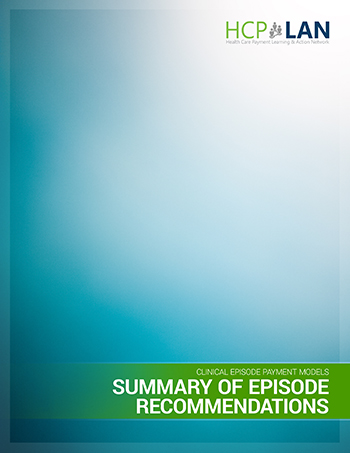 Chapter 2:
Chapter 2:


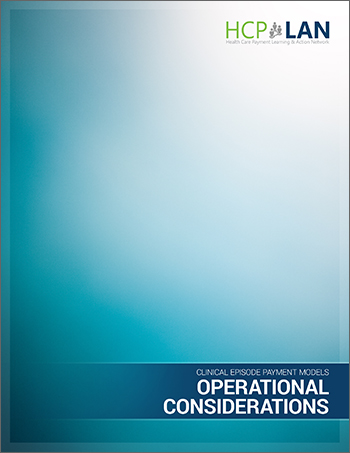 Chapter 6:
Chapter 6: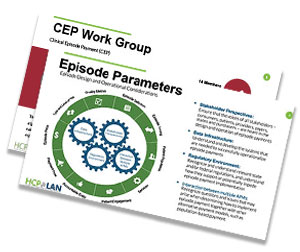
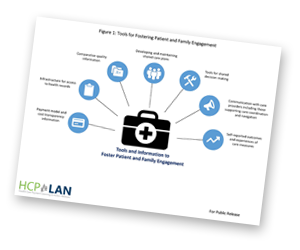
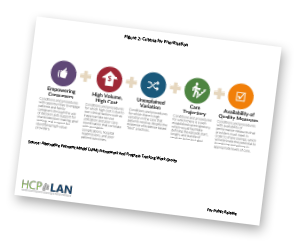
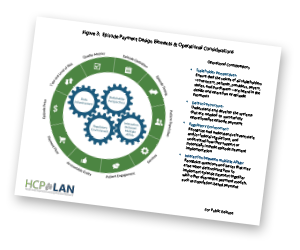
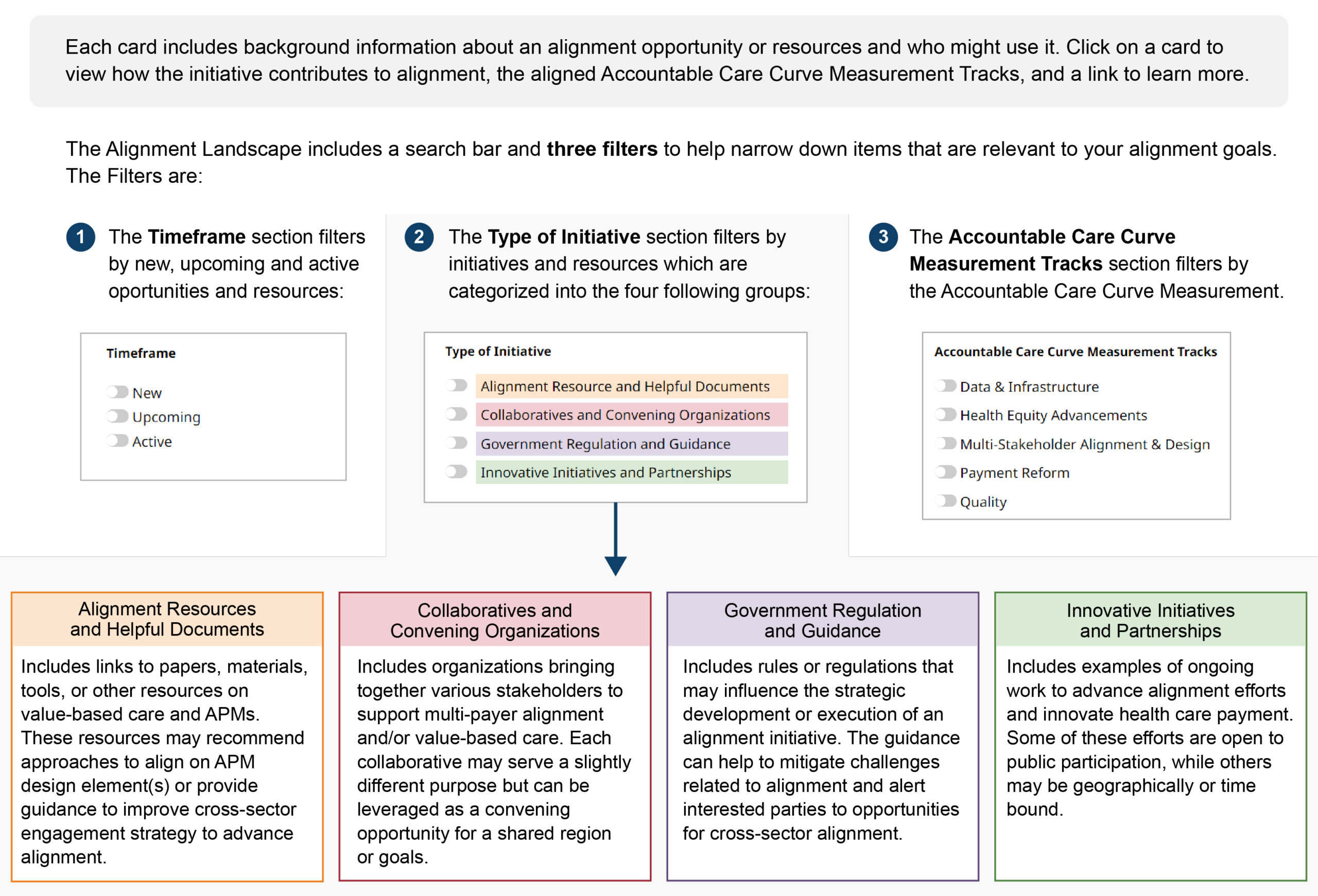



 Emily DuHamel Brower, M.B.A., is senior vice president of clinical integration and physician services for Trinity Health. Emphasizing clinical integration and payment model transformation, Ms. Brower provides strategic direction related to the evolving accountable healthcare environment with strong results. Her team is currently accountable for $10.4B of medical expense for 1.6M lives in Medicare Accountable Care Organizations (ACOs), Medicare Advantage, and Medicaid and Commercial Alternative Payment Models.
Emily DuHamel Brower, M.B.A., is senior vice president of clinical integration and physician services for Trinity Health. Emphasizing clinical integration and payment model transformation, Ms. Brower provides strategic direction related to the evolving accountable healthcare environment with strong results. Her team is currently accountable for $10.4B of medical expense for 1.6M lives in Medicare Accountable Care Organizations (ACOs), Medicare Advantage, and Medicaid and Commercial Alternative Payment Models. Mr. James Sinkoff is the Deputy Executive Officer and Chief Financial Officer for Sun River Health (formerly known as Hudson River HealthCare), and the Chief Executive Officer of Solutions 4 Community Health (S4CH); an MSO serving FQHCs and private physician practices.
Mr. James Sinkoff is the Deputy Executive Officer and Chief Financial Officer for Sun River Health (formerly known as Hudson River HealthCare), and the Chief Executive Officer of Solutions 4 Community Health (S4CH); an MSO serving FQHCs and private physician practices. Victor is the Chief Medical Officer for TennCare, Tennessee’s Medicaid Agency. At TennCare, Victor leads the medical office to ensure quality and effective delivery of medical, pharmacy, and dental services to its members. He also leads TennCare’s opioid epidemic strategy, social determinants of health, and practice transformation initiatives across the agency. Prior to joining TennCare, Victor worked at Evolent Health supporting value-based population health care delivery. In 2013, Victor served as a White House Fellow to the Secretary of Health and Human Services. Victor completed his Internal Medicine Residency at Emory University still practices clinically as an internist in the Veteran’s Affairs Health System.
Victor is the Chief Medical Officer for TennCare, Tennessee’s Medicaid Agency. At TennCare, Victor leads the medical office to ensure quality and effective delivery of medical, pharmacy, and dental services to its members. He also leads TennCare’s opioid epidemic strategy, social determinants of health, and practice transformation initiatives across the agency. Prior to joining TennCare, Victor worked at Evolent Health supporting value-based population health care delivery. In 2013, Victor served as a White House Fellow to the Secretary of Health and Human Services. Victor completed his Internal Medicine Residency at Emory University still practices clinically as an internist in the Veteran’s Affairs Health System. Dr. Brandon G. Wilson, DrPH, MHA (he, him, his) joined Community Catalyst as the Director of the Center for Consumer Engagement in Health Innovation, where he leads the Center in bringing the community’s experience to the forefront of health systems transformation and health reform efforts, in order to deliver better care, better value and better health for every community, particularly vulnerable and historically underserved populations. The Center works directly with community advocates around the country to increase the skills and power they have to establish an effective voice at all levels of the health care system. The Center collaborates with innovative health plans, hospitals and providers to incorporate communities and their lived experience into the design of systems of care. The Center also works with state and federal policymakers to spur change that makes the health system more responsive to communities. And it provides consulting services to health plans, provider groups and other health care organizations to help them create meaningful structures for engagement with their communities.
Dr. Brandon G. Wilson, DrPH, MHA (he, him, his) joined Community Catalyst as the Director of the Center for Consumer Engagement in Health Innovation, where he leads the Center in bringing the community’s experience to the forefront of health systems transformation and health reform efforts, in order to deliver better care, better value and better health for every community, particularly vulnerable and historically underserved populations. The Center works directly with community advocates around the country to increase the skills and power they have to establish an effective voice at all levels of the health care system. The Center collaborates with innovative health plans, hospitals and providers to incorporate communities and their lived experience into the design of systems of care. The Center also works with state and federal policymakers to spur change that makes the health system more responsive to communities. And it provides consulting services to health plans, provider groups and other health care organizations to help them create meaningful structures for engagement with their communities. Tamara Ward is the SVP of Insurance Business Operations at Oscar Health, where she leads the National Network Contracting Strategy and Market Expansion & Readiness. Prior to Oscar she served as VP of Managed Care & Network Operations at TriHealth in Southwest Ohio. With over 15 years of progressive health care experience, she has been instrumental driving collaborative payer provider strategies, improving insurance operations, and building high value networks through her various roles with UHC and other large provider health systems. Her breadth and depth of experience and interest-based approach has allowed her to have success solving some of the most complex issues our industry faces today. Tam is passionate about driving change for marginalized communities, developing Oscar’s Culturally Competent Care Program- reducing healthcare disparities and improving access for the underserved population. Tamara holds a B.A. from the University of Cincinnati’s and M.B.A from Miami University.
Tamara Ward is the SVP of Insurance Business Operations at Oscar Health, where she leads the National Network Contracting Strategy and Market Expansion & Readiness. Prior to Oscar she served as VP of Managed Care & Network Operations at TriHealth in Southwest Ohio. With over 15 years of progressive health care experience, she has been instrumental driving collaborative payer provider strategies, improving insurance operations, and building high value networks through her various roles with UHC and other large provider health systems. Her breadth and depth of experience and interest-based approach has allowed her to have success solving some of the most complex issues our industry faces today. Tam is passionate about driving change for marginalized communities, developing Oscar’s Culturally Competent Care Program- reducing healthcare disparities and improving access for the underserved population. Tamara holds a B.A. from the University of Cincinnati’s and M.B.A from Miami University.


 Dr. Peter Walsh joined the Colorado Department of Health Care Policy and Financing as the Chief Medical Officer on December 1, 2020. Prior to joining HCPF, Dr. Walsh served as a Hospital Field Representative/Surveyor at the Joint Commission, headquartered in Oakbrook Terrace, Illinois.
Dr. Peter Walsh joined the Colorado Department of Health Care Policy and Financing as the Chief Medical Officer on December 1, 2020. Prior to joining HCPF, Dr. Walsh served as a Hospital Field Representative/Surveyor at the Joint Commission, headquartered in Oakbrook Terrace, Illinois.








